Surface drainage of the plot itself
In suburban and suburban areas often excess moisture, which adversely affects the yield and condition of the foundation of the house. To combat this phenomenon, surface drainage is well suited.
Linear surface drainage
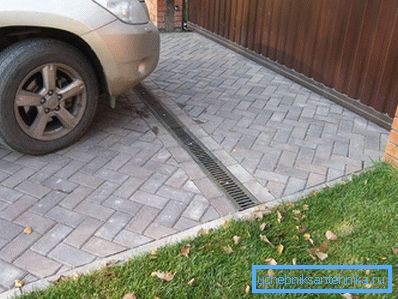
The device of the linear surface drainage provides for the laying of long gutters, closed on top of the gratings. The gutters are laid along the tracks, along the contour of the pads and in other places where water usually accumulates.
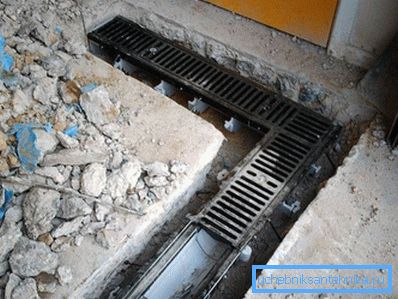
The linear system works according to a simple principle - water is collected in the gutters, flows into them under the established bias and into the collector well. Gutters are made from different materials. The most popular are the gutters of polymer concrete, concrete and plastic.
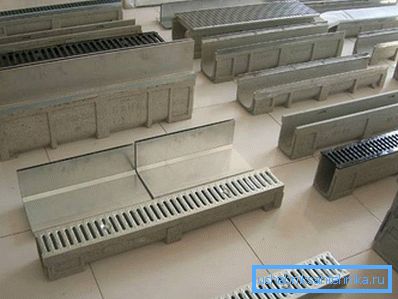
Tip! The linear surface drainage system prevents the underflooding of the foundation of the house by collecting water from the roof and surrounding areas and draining it into the sewer system.

If around the house it is necessary to arrange drainage, for this purpose you can use HDPE pipes with perforated surface. It can be done differently: sewer pipes are taken and a plurality of holes are drilled through them using a perforator or a drill. They must be performed along the entire length of the pipe in 3 rows.
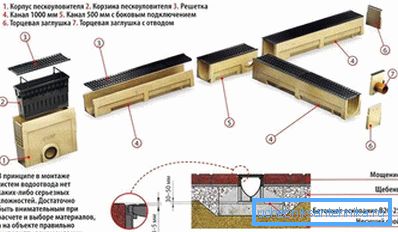
- At a distance of half a meter from the house, ditches are digging around the perimeter of the foundation, and perforated pipes are laid in them. The trenches are digging to such a depth that the sewer pipes are completely hidden in the ground.
- Using a shovel, alignment of all internal surfaces of the ditch is carried out.
- The bottom of the trench is covered with a layer of a mixture of gravel and sand.
- Pipes are stacked in a prepared ditch at a certain angle and displayed beyond the boundary of the site. Full access should be provided to the pipe openings. In trenches from opposite sides, a slope is made, which contributes to the rapid flow of rainwater into the pipes. With the help of such a linear drainage system around the house you can avoid the destruction of the foundation from the effects of water.
Dotted

Point drainage is used for local collection of rainfall. They are equipped in many places to which the space near the doors can be counted, the gutters that are installed on the roof to collect water from the roof, under watering taps coming out of the niches of the house, at the entrance and the parking lot, as well as at other points where moisture often accumulates and puddles are formed. Under the point drainage arrange wells from concrete, on which the top set of decorative grating.
There is an option with pumping water. To avoid clogging of pipes, sand traps are provided in the system. In addition to the sand trap, the drainage system includes storm water inlets, ladders, drainage systems and storm valves.
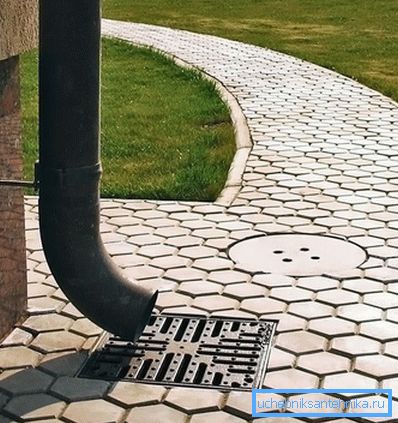
Tip! The system of point drainage with the right device can be well combined with linear collection and abstraction of water.
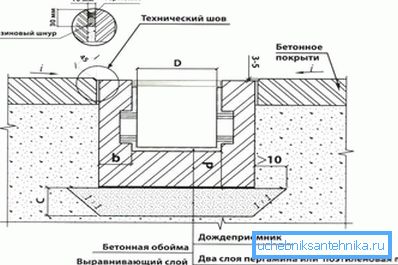
What elements are included:
- The storm water inlet is a rectangular tank. It is made of polymer concrete or plastic and is provided with branches that have access to the network of water discharge. Such a network, for example, can be storm sewers. To make the inlets easier to maintain, they will be equipped with special baskets into which large fractions of garbage are collected. In practice, there are also storm-water inlets in which hydraulic locks are mounted. The presence of siphons does not allow unpleasant smells to spread through the air near the house. The storm water inlet can be increased in height - for this purpose one element needs to be installed on another.
- Drain ladders have the form of a tank, equipped with a protective grating of a decorative type on top. This element is connected to the surface linear drainage or storm sewer system. The purpose of the ladder is to locally collect and divert water from tracks, equipped sites and other vulnerable points.
- The shower valve is a protective device of the drainage structure. This element does not allow water to flow in the opposite direction.
Detailed installation instructions below:
Plot drainage

The natural drainage system may not be enough if the area of the site is located in a marshy area or in a valley. In early spring, after the snow melts, the earth is saturated with water, which stays in place for a long time, and the sprouted plants begin to rot and perish. As a result, field work is lost from the schedule and the yield of the site does not reach the level that was planned.
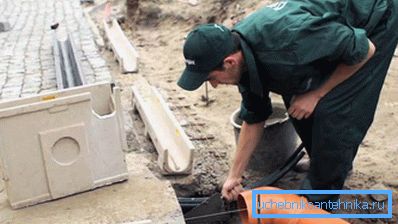
- Plot area is divided into equal sections. Narrow ditches are digging up to 0.5 m deep. They arrange ditches under a certain bias so that the water runs off and does not stand still. In order to fully utilize the entire area of the site, after draining the water in the right places, trenches are laid with branches, and sprinkled on top with a mixture of soil and manure. In temporary additional areas, crops can be grown for which dampness is the norm. In the autumn after harvesting, drainage trenches are restored to their original form - the layer of temporary soil is removed.
- Surface drainage of storm type is arranged in order to prevent flushing of the fertile soil from the site during heavy rains or precipitation falling for several days in a row. Drainage trenches are arranged with a slope for the subsequent removal of water from them. Grooves close up with concrete, arrange plastic or other trays in them. The option of trenches with retaining boards is possible, which abut against the walls of the grooves and are held in a vertical position by transverse struts. On top of such grooves make the track, and the trenches themselves covered with removable gratings.
- If the site is located in the middle of a large slope, there is a chance that short-term rain showers can wash away a layer of fertile soil. In this case, diversion drainage is necessary, the trenches of which will be arranged in such a way that the drain will collect and discharge water along an inclined surface, but outside the site. It is necessary to dig a rain trench across the slope, which will become an obstacle to the flow and drain the water along the edges of the usable area. Such a ditch should be constantly open. It can be turned into a ravine, sowing reeds or other similar plants, but it is better to strengthen the ditch with concrete, because such drainage structures quickly lose their original appearance, are washed out and destroyed.
Option of draining a plot
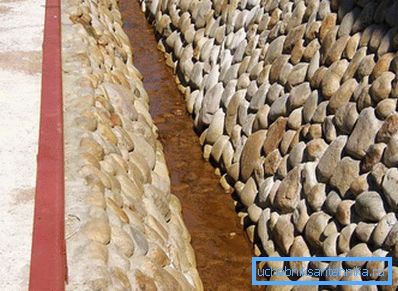
If the soil of the site consists predominantly of clay and loam, excess moisture can be disposed of using surface drainage, which involves the construction of a network of trenches over the entire usable area.
- First, a plan is drawn on the paper, onto which a network of ditches is placed, located throughout the site, and a drainage well where the collected water will be diverted. In order for the drainage to work properly, the trenches are set in a slope towards the water receiving object. If the site is on a slope, the direction of flow is chosen based on the given direction. If the surface of the earth is flat, the slope is created artificially. The number of trenches depends on the degree of soil moisture. The depth of the trenches should be about 0.5 m, the width will increase with the approach to the water intake.
- After the drainage system is ready, it is checked for quality of flow. To do this, water is released from the hose into the ditches and the flow velocity is monitored. If there are areas with stagnation of water, the slope in these places increases.
- If the test was successful, you need to do decorating trenches - bare ditches look unattractive. To do this, a layer of marble chips or decorative gravel is poured on the bottom of the ditches. Plants are planted on the “shores”.
